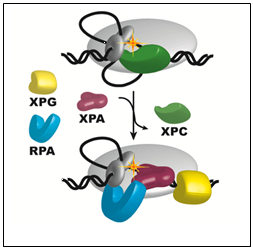 Nucleotide excision repair (NER) is a DNA damage repair pathway specialized for removing bulky lesions arising from exposure to various types of endogenous and exogenous environmental toxins. Defects in NER result in Xeroderma pigmentosum (XP), a spectrum of disorders characterized by hypersensitivity to UV exposure and dramatically increased incidents of skin cancer. There is currently no cure for XP diseases.
Nucleotide excision repair (NER) is a DNA damage repair pathway specialized for removing bulky lesions arising from exposure to various types of endogenous and exogenous environmental toxins. Defects in NER result in Xeroderma pigmentosum (XP), a spectrum of disorders characterized by hypersensitivity to UV exposure and dramatically increased incidents of skin cancer. There is currently no cure for XP diseases. Determining the NER mechanism at the molecular level has the potential to lead to the development of treatments for XP disorders. However, elucidating the molecular basis of human NER mechanism has been challenging because it is a multi-step process involving over 30 proteins. Moreover, while progress has been made to understand the mechanism of the simpler bacterial NER system, this does not translate well to human NER due to the lack of conservation of the repair proteins.
XPA is believed to play a key role in the NER mechanism as a scaffold that organizes the damaged DNA and other repair proteins in the right positions to ensure the correct excision of the lesion. The significance of XPA in NER is reflected from the fact many of XPA mutations are associated with severe phenotypes of XP disorders. Notably, these severe symptoms mostly results from mutations in the predicted DNA-binding domain of XPA. Though XPA-DNA binding activity is crucial for the proper function of NER, the molecular basis of how XPA interacts with the NER bubble is unknown.
My thesis project aims to structurally and functionally characterize XPA-DNA interactions to better understand their role in human NER and the correlation between the XPA mutations and XP symptoms.